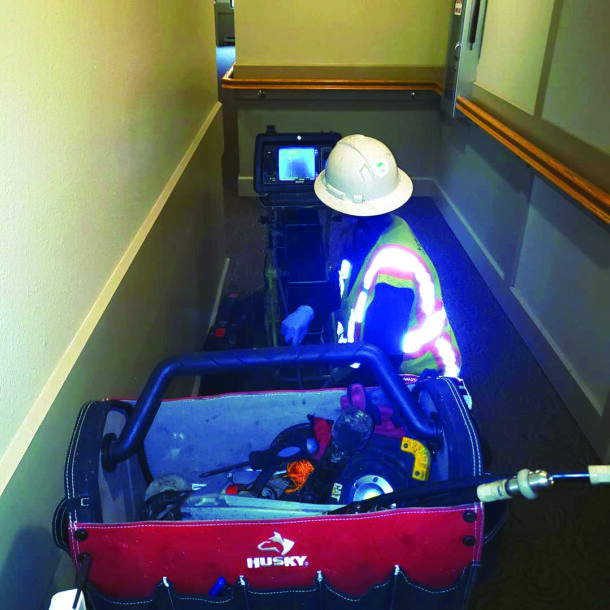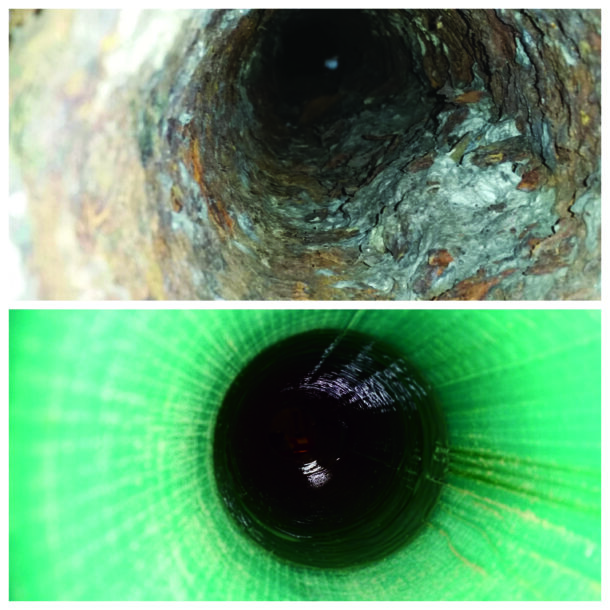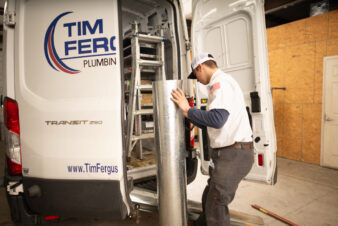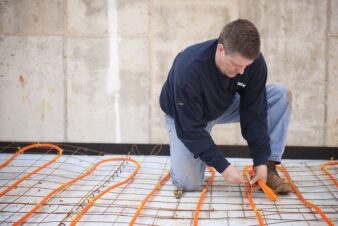The average U.S. commercial building is approximately 53 years old – including thousands of assisted living facilities – and many of the aging pipes in these facilities are in need of rehabilitation. Traditional total pipe replacement involves removing all old pipes and replacing them with new. This requires contractors to cut and remove drywall, flooring, fixtures and finishes to reach plumbing systems. Residents are unable to live in their dwellings during this destructive phase and must be placed in temporary housing for several days while demolition occurs, and water is turned off.
Given the physical and mental health challenges many assisted living seniors face, forcing them into unfamiliar and ill-equipped temporary housing can be extraordinarily disturbing for residents, potentially expose them to asbestos and incur dramatic costs. Yet that is what occurs when a senior living community undergoes a total pipe replacement to repair leaking pipe systems.
Today’s modern In-Wall Pipe Rehabilitation process offers senior living communities reliable repair of vertical and horizontal piping systems without disrupting residents’ lives or incurring relocation expenses. This non-invasive form of pipe repair is ideal for pipes up to 12” in diameter and allows residents to remain in their familiar surroundings during the repair process.

In-Wall CIPP Rehabilitation eliminates excavation and resident relocation, making it a minimally disruptive cost-effective alternative to total pipe replacement.
This field-proven technique has restored old and new high-rise commercial and multi-tenant residential properties’ plumbing systems faster and more cost effectively with less environmental impact compared to total pipe replacement for more than two decades. It’s effective for mains, stacks, vents and branch lines, which encompasses kitchens, tubs and toilets.
Preparation for In-Wall Pipe Rehabilitation begins with gaining access to each stack from the top floor. A basement bypass system is installed and removed each day, which allows residents to remain in their units while the project progresses. The stacks are then descaled and cleaned. CIPP liner is installed from the top floor to the basement bypass system. Once the liner cures, each branch line is reinstated robotically from the top floor access point. Completing one stack each week minimizes disruption and ensures residents have access to their bathrooms and kitchens each night.
Once vertical stacks are restored, horizontal pipes are addressed by reinstalling the basement bypass system to allow pipes under the building’s concrete slab to be descaled, cleaned and lined while each floor remains operational. CIPP Liner is then installed from each stack, moving toward the main sewer line outside the building. When the liner’s cure is complete, each branch line is reinstated robotically.
A comparison of a total pipe replacement and non-invasive In-Wall Pipe Rehabilitation project immediately demonstrates the advantages of the in-wall pipe rehab process. A retirement community in Washington State consisting of three multi-story buildings underwent a total pipe replacement. The cost to relocate the community’s residents during the pipe replacement totaled over $1 million alone. In contrast, another Washington State retirement community that employed the in-wall pipe rehabilitation process using Vortex’s Quad-Cure® 100% Solids Epoxy Resin and Liner didn’t require residents to leave their units, saving the exorbitant relocation, demolition and reconstruction expenses. Additionally, the in-wall pipe repair project was completed in roughly half the time of a total pipe replacement.
Depending on pipe diameters and conditions, there are several non-invasive in-wall pipe repair options that are significantly less expensive than traditional total replacement. A broad range of Quad-Cure Epoxy Resins and Liners are used in In-Wall Pipe Rehabilitation systems. Whether the repair involves main lines, laterals, branch lines, verticals, sectional repairs, cold weather or environmentally-sensitive areas, these materials stop leaks, improve flow and restore structural integrity. Brush-in-Place-Pipe (BIPP) uses 100% solids epoxy lining material to reline pipes as small as 1 ¼-inch diameter and corroded cast iron pipes. CIPP utilizes epoxy resins to restore structural integrity to cracked or physically compromised larger diameter pipes. UV CIPP, a superior cost-comparable alternative to vinyl esters, employs methacrylate resins that fully adhere to vertical plastic and clay pipes, such as stack and vent pipes, for an impregnable bond.

In-Wall Pipe Rehabilitation provides reliable, durable pipe repair communities and residents can depend upon. Shown: Vortex Companies’ Quad-Cure Epoxy Resin and Liner.
It’s common for a variety of materials to be required for a trenchless plumbing and sewer pipe rehabilitation project. Sourcing materials from multiple vendors can take time, extending a project’s duration and cost. Vortex’s ability to be a single source for all needed materials – including customized materials – expedited the completion of an Oregon retirement community’s In-Wall Pipe Rehabilitation. With 10 floors, 18 stacks and more than 2500 linear feet of deteriorating cast iron pipes, In-Wall Pipe Rehabilitation was an ideal choice for the project to avoid disrupting and relocating the community’s 150 elderly residents. This project required multiple materials, which Vortex provided to eliminate sourcing delays and enable the expansive undertaking to be completed in just five months while residents remained in their units.
Traditional total pipe replacement requires more manpower, time and materials than modern CIPP and pipe relining methods. It also incurs more costs as excavation damage to drywall, flooring and more must be repaired forcing resident relocation due to the inability to access water.
In-Wall Pipe Rehabilitation maintains residents’ quality of life while providing durable, reliable pipe repair. As the in-wall pipe systems in high-rise and multi-story buildings age, this modern trenchless pipe repair approach represents an optimal, cost-effective option that benefits tenants and building managers alike.
Caption: Quad-Cure® Epoxy Resin creates a structurally sound pipe within a pipe during non-invasive In-Wall Pipe Rehabilitation projects.
In-Wall Pipe Rehabilitation provides reliable, durable pipe repair communities and residents can depend upon. Shown: Vortex Companies’ Quad-Cure Epoxy Resin and Liner.
In-Wall CIPP Rehabilitation eliminates excavation and resident relocation, making it a minimally disruptive cost-effective alternative to total pipe replacement.
Author: Andrew Gonnella is President, Products Division for Vortex Companies. In this role, he oversees the development and expansion of Vortex’s existing product line, identifies new products and develops new distribution channels. He holds a Bachelor of Arts degree from University of Maryland College Park and a Master of Business Administration from University of Maryland Robert H. Smith School of Business.




Join the conversation: